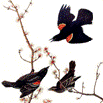Center, Internet, Wildlife Damage Management

Bird Control Seminars Proceedings
Document Type
Article
Date of this Version
September 1968
Abstract
I'm going to speak on wetting agents, which are a class of surface-active agents or surfactants along with soaps or detergents. I would like to second John's philosophy on this balanced approach. Our blackbird problem in Ohio and Michigan is sufficiently serious that we can scarcely afford to overlook any measure of control. Wetting agents are not a new happening on the blackbird damage control scene. Actually since the early '60's we have been interested in finding the ideal agent and method of application for lethal control of blackbirds, starlings, and their roosts. The principle, as with so many other damage control techniques, is relatively simple: get roosting birds wet enough when the weather is cold, the temperature drops to 30 or so degrees, and they succumb to heart failure, respiratory system failure, etc. In practice however, as in many other damage control techniques, the story is not quite so easily told. The advent of the newer biodegradable surfactants have all but eliminated one of the problems, that of chronic water pollution. However numerous other problems must be solved before this method can leave the drawing board.

